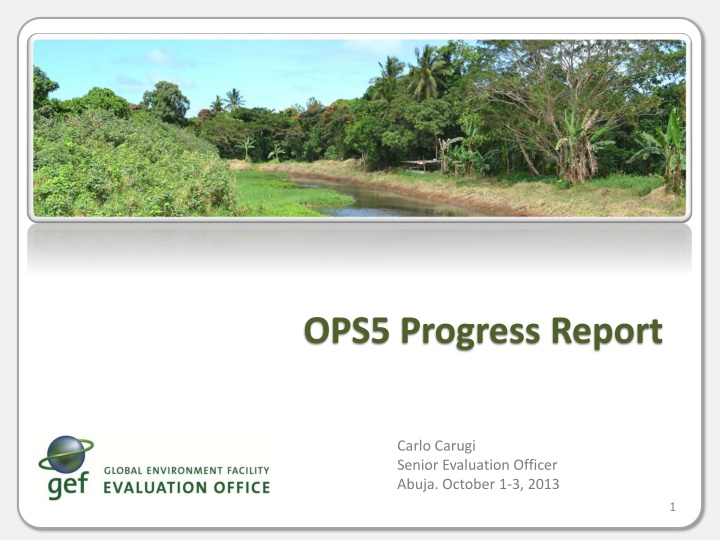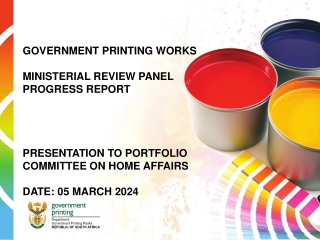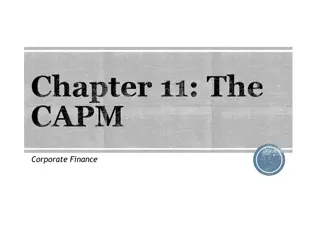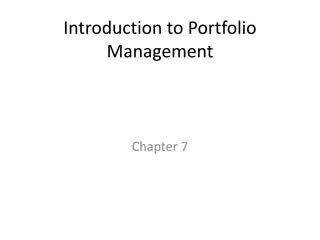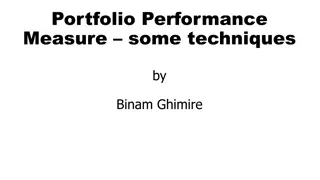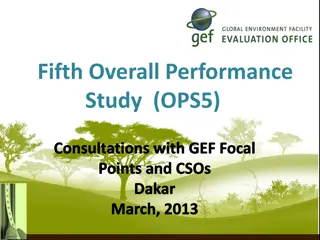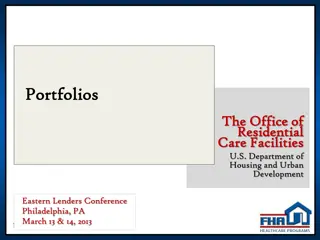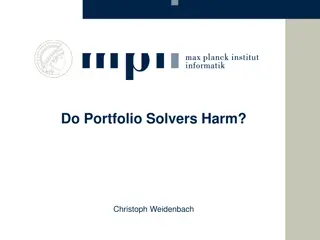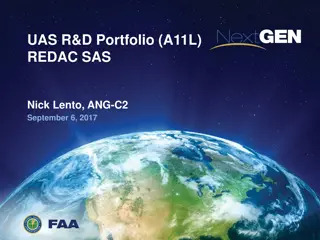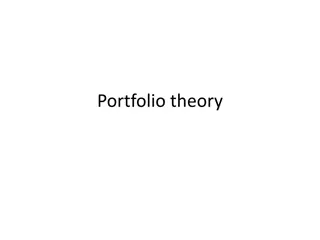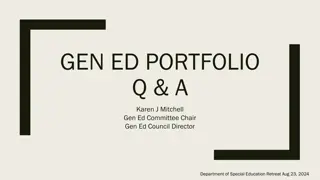OPS5 Progress Report - Setting the Stage and Portfolio Analysis
This report highlights issues for the OPS5 replenishment meeting, including performance concerns and the analysis of multi-focal area projects. It discusses the impact of MFA projects and the programming of international funding for environmental support.
Uploaded on Mar 14, 2025 | 0 Views
Download Presentation

Please find below an Image/Link to download the presentation.
The content on the website is provided AS IS for your information and personal use only. It may not be sold, licensed, or shared on other websites without obtaining consent from the author.If you encounter any issues during the download, it is possible that the publisher has removed the file from their server.
You are allowed to download the files provided on this website for personal or commercial use, subject to the condition that they are used lawfully. All files are the property of their respective owners.
The content on the website is provided AS IS for your information and personal use only. It may not be sold, licensed, or shared on other websites without obtaining consent from the author.
E N D
Presentation Transcript
OPS5 Progress Report Carlo Carugi Senior Evaluation Officer Abuja. October 1-3, 2013 1
Setting the Stage Progress Report requested by first replenishment meeting This report will flag issues that need to be taken up in the replenishment on the basis of ongoing work for OPS5 In addition: first impression of how recommendation of first report is taken up (on MFA and on broader adoption) In addition: performance issues emerging as problematic, whereas GEF-6 proposals do not yet fully discuss these 2
Issues Portfolio Programming Impact Performance/project cycle Results based management Work in progress 3
Portfolio Further analysis of multi-focal area projects (MFA) 102 projects with multi-focal objectives but not approved as MFA were added to analysis Total MFA: 17% of projects and 22.5% of funding (47% in GEF-5) Analysis on integrated versus non- integrated MFA activities in projects 4
MFA portfolio MFA projects have same percentage of moderately satisfactory and higher outcome ratings as single focal area projects (FA) But if we look only at satisfactory and highly satisfactory ratings, FAs score higher This may be indicative for the relative complexity of MFAs MFAs with integrated activities score better on sustainability than MFAs with bundled activities M&E of MFAs scores lower than M&E of FAs 5
MFA issues MFAs have potential to effectively and sustainably address connected focal area issues through integrated activities The M&E burden on MFAs, as noted in several country portfolio evaluations, is confirmed and should be addressed MFAs do not receive much attention in the GEF-6 proposals 6
Programming International funding of environmental support has doubled from 2007 to 2011 GEF has benefited from this, but with a relatively lower increase 7
Available global public funding> $ 10 billion Global public funding needs> $ 100 billion Public spending on over-use of resources> $ 1 trillion 8
Issue 1 Expectations for GEF-6 are not as positive as they were for GEF-5 Proposals for GEF-6 double the number of program level objectives in focal areas, in set-asides and in corporate programs compared to GEF-5 Potential underfunding of focal areas, countries and/or modalities of the GEF needs to be discussed and taken into account when considering programming for GEF-6 9
NPFE mid-term evaluation Report will be presented to Council in November Three issues emerge for the 2nd replenishment meeting: NPFEs were highly relevant to countries Actual programming was with exceptions unsuccessful Implementation of the support was highly inefficient 10
NPFE relevance Support for programming helps address the pre-project cycle phase that often remains a black box While the programming itself often was unsuccessful, it has helped countries set up better mechanisms for coordination and future programming Stakeholder involvement increased in several NPFE countries 11
NPFE effectiveness Only a limited number of projects identified during NPFEs were approved Many project concepts were not eligible for GEF support Concepts not commensurate with funding levels Other priorities took over after the NPFE 12
NPFE efficiency Long initial time delays due to choice of modality Lack of guidance on eligibility and funding levels Shifts in guidance, one in defiance of Council decision Shift: countries were not allowed to enter PIFs if NPFE had not been finished, despite Council request that they should be able to do so 13
Issue 2 Programming of GEF support to countries and regions will remain crucial in GEF-6 and support for this should continue A revised NPFE could include priority setting for regional issues Follow-up to Expanded Constituency Workshops could play a role Timing should be at end of GEF period, not at the start of a new period 14
Impact Request of first replenishment meeting to provide further analysis on broader adoption Larger cohort of projects studied Analysis focused on crucial factors that speed up progress toward impact More nuanced analysis to provide greater insight New MFA cohort not yet fully integrated, so more work will need to be done for the final report of OPS5! 15
Impact in First Report Four mechanisms for broader adoption identified Mainstreaming and replication tend to lead to slower broader adoption than up-scaling and market change This means projects should include design elements that initiate up-scaling and market change GEF-6 focal area proposals (doc. I) seem to prefer mainstreaming and replication This may be an issue of terminology, but it may also lead to project proposals that focus less on broader adoption 16
Broader Adoption Mainstreaming: Information, lessons, or specific results of the GEF are incorporated into broader stakeholder mandates and initiatives such as laws, policies, regulations, and programs Replication: GEF-supported initiatives are reproduced or adopted at a comparable administrative or ecological scale, often in another geographical area or region Scaling-up: GEF-supported initiatives are implemented at a larger geographical scale, often expanded to include new aspects or concerns that may be political, administrative, or ecological in nature Market change: GEF-supported initiatives catalyze market transformation by influencing the supply of and/or demand for goods and services that contribute to global environmental benefits
Definitions of Impact Positive and negative, primary and secondary long- term effects produced by an intervention, directly or indirectly, intended or unintended (OECD/DAC) Environmental impact: changes in biophysical parameters Direct impact: changes attributable to an intervention Long term impact: changes emerging over time in long duration biophysical processes Impact scales go from single sites to system-level impact Globally significant impacts have local impact as well, but not all local impact is globally significant Social and economic impacts are essential to achieve environmentally sustainable development Text box 1 18
Overview of Impact Cohort NO. OF PROJECTS NO. OF PROJECTS MF 7% PP 2% OD 1% FOCAL AREA FOCAL AREA LD 4% BD CC IW LD MF OD PP Grand Total BD CC IW LD MF OD PP Grand Total 234 113 58 20 33 IW 12% BD 50% 5 CC 24% 10 473* includes only projects approved as multi-focal, not projects implemented as such under individual focal areas *18 projects excluded from OPS4 & OPS5 cohorts due to unavailable TEs or insufficient information in TEs 19
Broader Adoption at Project Completion 120% No significant broader adoption taking place Some broader adoption initiated Some broader adoption initiatives adopted/ implemented Most broader adoption initiatives adopted/ implemented 100% 80% 60% 40% 20% 0% BD CC IW LD MF OD PP Total 20
Mechanisms for Broader Adoption Mechanisms/processes for participation & trust- building/conflict resolution Government structures Laws/ Policies/ Regulations Management systems Financial Mechanisms Technologies/ infrastructure Management frameworks/ approaches 0% 5% 10% 15% 20% 25% 30% 35% 40% 45% 50% Mainstreaming Replication Scaling-up Market Change 21
Broader Adoption and Environmental Impact With Environmental Impact No Environmental Impact No significant broader adoption taking place 76% Some broader adoption initiated 55% 45% Some broader adoption initiatives adopted/ implemented 72% 28% Most broader adoption initiatives adopted/ implemented 90% 10% 0 20 40 60 80 100 120 140 160 180 22 No. of Projects
Factors Affecting Progress Towards Impact CONTRIBUTING FACTORS HINDERING FACTORS Good engagement of stakeholders Highly relevant technology/approach Broader adoption processes initiated using project resources Poor project design No activities to sustain project outcomes PROJECT- RELATED Country support Previous/current related initiatives (by government, global events, etc.) Other stakeholder support Other unfavorable political/ policy conditions/events Unfavorable economic conditions/events/ drivers Lack of country support CONTEXTUAL 23
From Immobility to Progress -55% -45% -35% -25% -15% -5% 5% 15% 25% 35% 45% 55% Poor project design No activities to sustain project outcomes Lack of country support Other stakeholder support Broader adoption processes initiated using project resources Less successful More successful EXTENT OF BROADER ADOPTION 24
Factors Affecting Progress Toward Impact at Project Completion CONTRIBUTING FACTORS HINDERING FACTORS Good engagement of stakeholders Highly relevant technology/approach Broader adoption processes initiated using project resources Poor project design No activities to sustain project outcomes PROJECT- RELATED Country support Previous/current related initiatives (by government, global events, etc.) Other stakeholder support Other unfavorable political/ policy conditions/events Unfavorable economic conditions/events/ drivers Lack of country support REALM OF GEF CONTROL CONTEXTUAL 25
Issue 3 Project design issues hindered 74% of less successful projects These projects were also more susceptible to negative contextual conditions Projects that engage stakeholders and that include activities to broader adoption during implementation tend to fare well despite unfavorable contextual conditions Project design and implementation should ensure engagement of stakeholders and allocation of resources towards activities supporting broader adoption A community of practice on broader adoption could bring together country and agency experiences and include expertise from STAP, the Evaluation Office and the Secretariat 26
Performance Project cycle: analysis has now moved from September 30 2012 to include June 30 2013 Final report will go to September 30, 2013 Indicative finding: standard of 18 months from Council approval to CEO endorsement is not met for more than 50% of FSPs Further analysis is done for reasons why Replenishment should discuss project cycle issues at its third meeting in December 27
But FSPs under programmatic approaches seem to go faster 29
Issue 4 The reasons for the failure to meet the 18 month standard are still subject of further analysis The Secretariat in its responses to PIFs and CEO endorsement requests has been timely; other factors are being explored The project cycle remains slow and cumbersome and will need to become an issue for discussion in the third replenishment meeting, when the final analysis of OPS5 is available 30
RBM & M&E GEF-5 increased the number of goals, objectives, targets, indicators and tracking tools Compliance with monitoring requirements has gone down over GEF-4 and GEF-5 M&E ratings are slowly decreasing Data generated through GEF support are not always institutionally safeguarded or available The cost of monitoring increases if many indicators and targets are adopted M&E budgeting may not have been sufficient RBM and monitoring need to find the right balance between funding for operations and funding for data gathering and analysis 31
RBM and monitoring issue No assessment of costs and benefits of adequate monitoring of the full list of GEF-5 indicators was presented to the fifth replenishment Ongoing work on tracking tools puts a question mark on the completeness and reliability of the data reported in AMR part 2 The GEF may want to measure too much in too great a detail 32
GEF-6 increasing the burden? The GEF-6 proposals present a significant increase in goals, objectives, programs and components SGP as example: it is proposed to introduce 4 programs within SGP, whereas in GEF-5 SGP had no sub-programs The on-going joint evaluation of SGP indicates that M&E and RBM in SGP is unrealistic; adding programs will potentially inflate the problem The first phase findings will become available shortly and could be taken up 33
Issue 5 The GEF should consider reducing the burden of targets, indicators and tracking tools and reform its results based management system accordingly, so that what gets measured gets measured better, more reliable and more consistent 34
Work in Progress Adaptation Gender CSO engagement Private Sector engagement STAP Health of the Network Knowledge Management Co-financing 35
Thank you ops5@thegef.org www.gefeo.org 36
